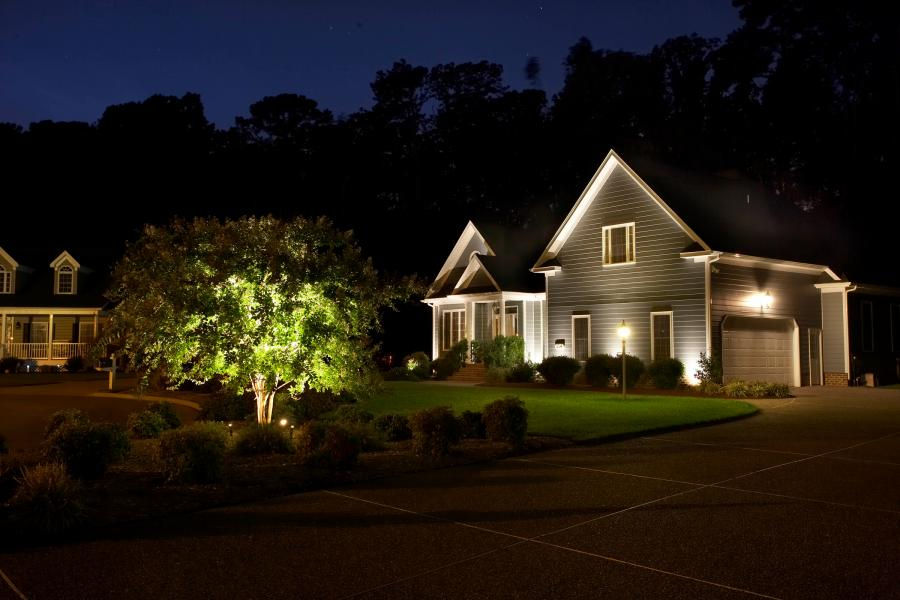Designing the Best Low Voltage Landscape Lighting System
- Briana Johnson
- Aug 14, 2024
- 5 min read
Low-voltage landscape lighting is more than just a functional addition to your outdoor space—it's a way to enhance the beauty and usability of your garden, pathways, and exterior features.

This guide will walk you through the basics of designing a low-voltage landscape lighting system, helping you understand what’s involved in planning, selecting, and installing the right lighting for your home.
Table of Contents
What is Low Voltage Landscape Lighting?
Low-voltage landscape lighting operates on 12 volts of electricity, much lower than the standard 120 volts used in most household systems. This reduced voltage not only ensures safety but also allows for more creative and flexible lighting designs.
Some key benefits of low-voltage lighting include:
Energy Efficiency: Low-voltage lighting systems consume less electricity, contributing to lower energy bills and a more sustainable lifestyle.
Safety: The lower voltage reduces the risk of electrical shock, making it ideal for outdoor use in residential areas.
Versatility: These systems offer a wide range of design possibilities, allowing for customized lighting solutions that can be tailored to the unique features of your landscape.
How It Works
A typical low-voltage landscape lighting system includes a transformer, light fixtures, wiring, and connectors. The transformer steps down the household voltage to a safer level, powering the strategically placed fixtures throughout your landscape. This setup enables precise control over the distribution and intensity of light, ensuring that every part of your outdoor space is beautifully illuminated.
Planning Your Landscape Lighting Design
Evaluating Your Outdoor Space
The first step in designing a low-voltage landscape lighting system is to assess your outdoor space. Consider the areas where lighting will add the most value—think about pathways for safety, garden beds for highlighting plants, or architectural features that deserve attention.
Start by walking through your outdoor area at dusk. Take note of the naturally darker spots that could benefit from lighting, such as:
Pathways and Driveways: Ensure safe navigation by illuminating walkways and driveways.
Garden Features: Highlight flower beds, trees, or water features to create a visually appealing landscape.
Architectural Elements: Draw attention to unique aspects of your home, such as stone walls, columns, or entryways.
Balancing aesthetics and functionality is crucial here; the goal is to create an inviting atmosphere while ensuring adequate lighting for safety and visibility.
Selecting the Right Lighting Fixtures
Choosing the right fixtures is a key part of your landscape lighting design. The type of fixture you select should align with the lighting effect you want to achieve and the specific needs of your space.
Here are some common types of low-voltage landscape lighting fixtures:
Path Lights: Ideal for illuminating walkways, driveways, and garden paths. They provide a soft, inviting glow.
Spotlights: These fixtures are perfect for highlighting specific features, such as trees, statues, or architectural elements.
Wall Wash Lights: Used to cast a broad, even light on flat surfaces like walls or fences, enhancing the depth and texture of your landscape.
Deck and Step Lights: These are used to light up stairs or deck areas, improving safety and adding ambiance to outdoor living spaces.
When selecting fixtures, consider the durability, material, and style to ensure they complement your overall landscape design and withstand the elements.
Design Principles to Consider
Successful landscape lighting design involves more than just placing lights around your yard. Here are a few design principles to keep in mind:
Layering Light: Use a combination of different lighting types (ambient, task, and accent) to create depth and dimension in your landscape.
Creating Focal Points: Highlight key areas or features, such as a beautiful tree or a water feature, to draw the eye and add visual interest.
Avoiding Over-Illumination: Too much light can detract from the beauty of your landscape. Aim for a balance that enhances rather than overwhelms the natural surroundings.
Steps to Installing Low Voltage Landscape Lighting
Once the design is finalized, our team at Gardenworks Inc. can meticulously plan the installation process. This includes mapping out the layout, calculating the required wattage, and selecting the appropriate transformers to ensure optimal performance.
We also consider factors such as voltage drop, which can occur if the wiring runs too far from the transformer. By carefully planning the wiring routes and possibly using multiple transformers, we ensure consistent and reliable lighting across your entire landscape.
Professional Installation
Our experienced team handles every aspect of the installation process, ensuring that your low-voltage landscape lighting system is installed to the highest standards. Here’s what you can expect during installation:
Positioning and Installing Fixtures: We carefully place each fixture according to the design plan, securing them in the ground and ensuring they are correctly angled to achieve the desired lighting effect.
Laying and Connecting Cables: We run low-voltage cables from the transformer to each fixture, following the planned layout. All connections are made using waterproof connectors to protect against the elements.
Connecting to the Transformer: The main cable is attached to the transformer, which is then plugged into a standard outdoor GFCI outlet. Most transformers we use have built-in timers or photocells, allowing for automated lighting schedules.
Testing and Adjusting: Once the installation is complete, we thoroughly test the system, making any necessary adjustments to ensure perfect lighting coverage and functionality.
Tips for a Successful Lighting Design
Striking the right balance between aesthetics and functionality is key to a successful landscape lighting design. Here are a few tips to help you achieve this:
Use Lighting to Guide: Lighting can subtly guide people through your outdoor space, creating a sense of flow and coherence.
Highlight the Best Features: Focus on the most attractive elements of your landscape and architecture. Less is often more when it comes to accent lighting.
Think About the User Experience: Consider how your outdoor space is used at different times of the day and year, and design your lighting accordingly.
Common Mistakes to Avoid
Even the best-designed plans can fall short if certain common mistakes are made. Here are a few to watch out for:
Over-Illumination: Too many lights can make your outdoor space feel harsh and overexposed. Aim for subtlety and focus on key areas.
Improper Fixture Placement: Poor placement can lead to uneven lighting or glare. Take the time to experiment with fixture positions before finalizing the installation.
Neglecting Maintenance: Outdoor lighting systems require regular maintenance to keep them looking and performing their best. Be sure to clean lenses, replace bulbs, and adjust fixtures as needed.
The Value of Professional Landscape Lighting Design
Every outdoor space has the potential to be transformed into a beautiful, functional retreat with the right lighting design. At Gardenworks Inc., we specialize in creating the best low-voltage landscape lighting systems that not only illuminate but also transform your Sonoma County property. Our team of experts brings years of experience and a deep understanding of landscape lighting to every project, ensuring that your vision is brought to life with precision and care.
Whether your project involves a small garden or an expansive estate, our professional guidance can make all the difference. We handle everything from design to installation, using high-quality materials and industry-leading techniques to create a lighting system that will enhance your outdoor space for years to come.
A well-designed lighting system also requires regular maintenance to ensure it continues to perform as intended. At Gardenworks Inc., we provide ongoing support, including routine maintenance, system adjustments, and upgrades, to keep your outdoor lighting in optimal condition. Our commitment to customer satisfaction means we’re here for you long after the installation is complete.
If you’re ready to explore the possibilities for your Sonoma County property, contact Gardenworks Inc. for a personalized consultation. Let us help you create an outdoor space that truly shines.






